Van Dyke beard

A Van Dyke (also spelled Vandyke, Vandyck, Van Dyck or Van Dijk) is a style of facial hair named after 17th-century Flemish painter Anthony van Dyck.[1][2] A Van Dyke specifically consists of any growth of both a moustache and goatee with all hair on the cheeks shaven.[1] Even this particular style, though, has many variants, including a curled moustache versus a non-curled one and a soul patch versus none.
This style of beard was popular in Europe in the 17th century.[3] It died out in Britain with the Restoration, when French styles and wigs became popular. For some time after, however, some men, known as "vow-beards", continued to wear them, vowing to wear them until the King did so again.[4] It became popular in the United States in the 19th century. Chicago Chronicle columnist Edith Sessions Tupper condemned this style, along with the goatee, as indicative of a man "who was selfish, sinister, and pompous as a peacock."[2] The style is sometimes called a "Charlie" after King Charles I of England, who was painted by Van Dyck with this type of beard.[5]
Van Dykes in history
The style was worn by Van Dyke himself, and by many of the sitters for his portraits, including King Charles I of England.[1] The Russian Marxist revolutionary Vladimir Lenin also wore a Van Dyke. The Van Dyke had a revival in the 19th century and was worn by several well-known figures including General Custer (among other styles) and the actor Monty Woolley. Colonel Sanders would also qualify as having a Van Dyke.
The word pickedevant is a little-known synonym for a Van Dyke beard.
Examples
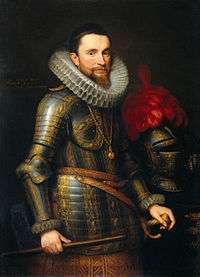 Ambrogio Spinola, by Michiel van Mierevelt (1609)
Ambrogio Spinola, by Michiel van Mierevelt (1609)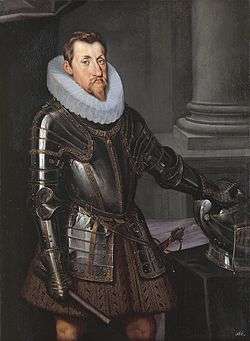 Ferdinand II, Holy Roman Emperor, unknown artist (1614)
Ferdinand II, Holy Roman Emperor, unknown artist (1614)
 Gustavus Adolphus, attrib. Jacob Hoefnagel (1624)
Gustavus Adolphus, attrib. Jacob Hoefnagel (1624) Jacobus Arminius , by Willem Isaacsz Swanenburg (1625)
Jacobus Arminius , by Willem Isaacsz Swanenburg (1625)- Charles I of England by Anthony van Dyck (1635-6)
 Cardinal de Richelieu, by Philippe de Champagne (c. 1642)
Cardinal de Richelieu, by Philippe de Champagne (c. 1642) António María Esquivel (1847)
António María Esquivel (1847)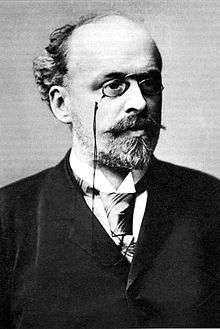
 Self-portrait by Jean Augustin Daiwaille Dutch portrait painter (1801-1850)
Self-portrait by Jean Augustin Daiwaille Dutch portrait painter (1801-1850)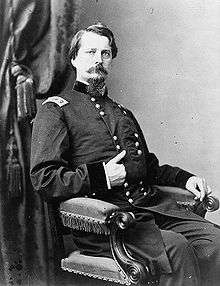 Winfield Scott Hancock (1863)
Winfield Scott Hancock (1863) George Armstrong Custer (1865)
George Armstrong Custer (1865)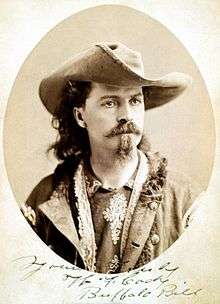 Buffalo Bill (William Cody) (c. 1875)
Buffalo Bill (William Cody) (c. 1875) Edward S. Curtis (1899)
Edward S. Curtis (1899)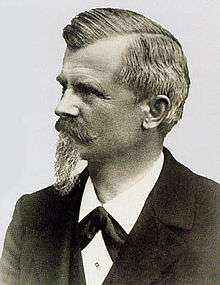 Wilhelm Maybach (1900)
Wilhelm Maybach (1900)
 Adolphe Lalyre
Adolphe Lalyre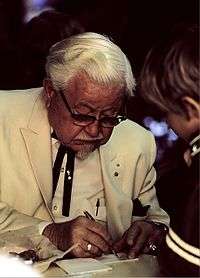 Colonel Sanders (c. 1974)
Colonel Sanders (c. 1974) Pierce Brosnan (2005)
Pierce Brosnan (2005) Christian Bale, actor (2009)
Christian Bale, actor (2009)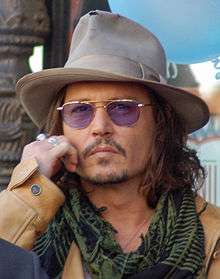 Johnny Depp (2011)
Johnny Depp (2011)
References
- 1 2 3 Sherrow, Victoria (2001). For Appearance' Sake. Greenwood Publishing Group. pp. 114–115. ISBN 978-1-57356-204-1.
- 1 2 Peterkin, Allan (2001). One Thousands Beards. Arsenal Pulp Press. pp. 172–173. ISBN 978-1-55152-107-7.
- ↑ Sherrow, Victoria (2006). Encyclopedia of Hair. Greenwood Publishing Group. p. 59. ISBN 978-0-313-33145-9.
- ↑ "The Westminster Review". 62 (121). Leonard Scott Publication. July 1854: 33.
|chapter=ignored (help) - ↑ Shipley, Joseph Twadell (2001). The Origins of English Words. JHU Press. p. 28. ISBN 978-0-8018-6784-2.
External links
-
 Media related to Van Dyke beards at Wikimedia Commons
Media related to Van Dyke beards at Wikimedia Commons